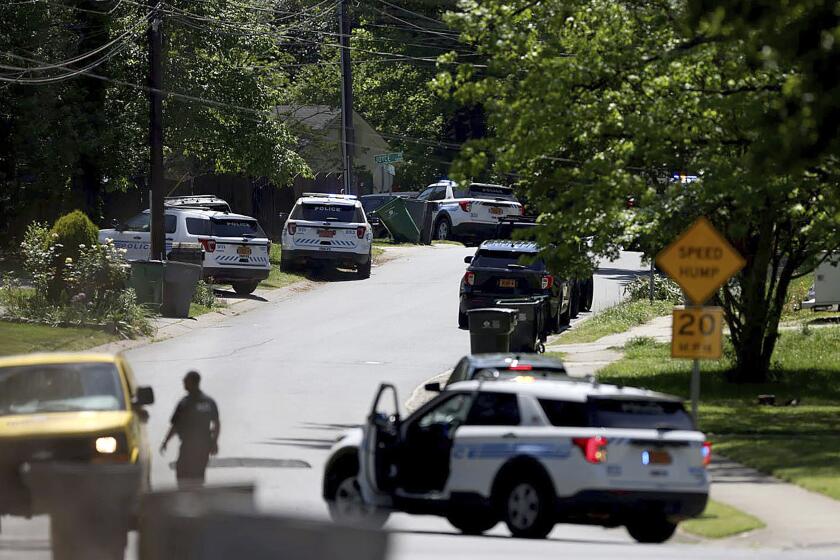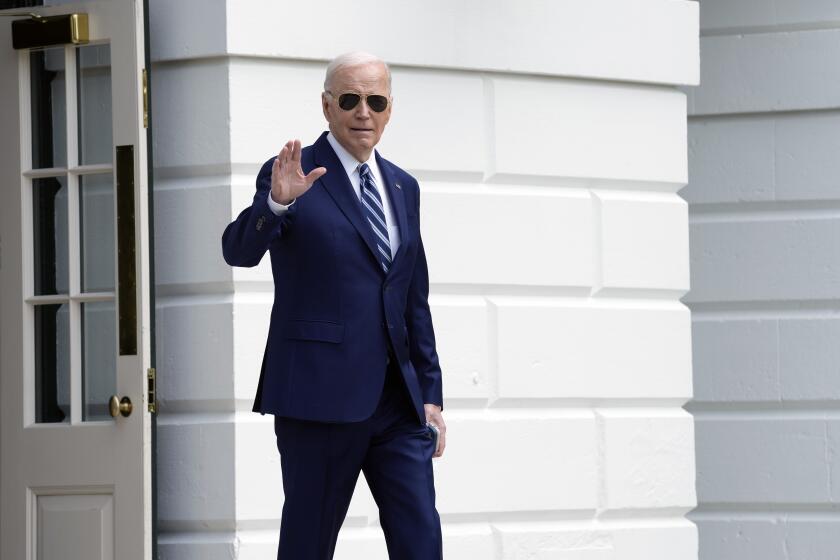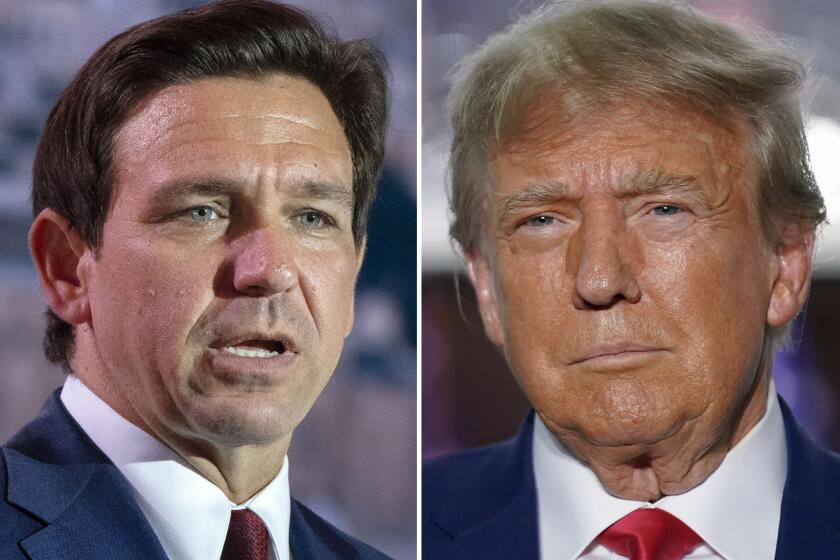Candidates Seek Lighter Load for School Counselors
A deepening shortage of guidance counselors in California’s public high schools has emerged as a gubernatorial campaign issue after years of complaints from educators who say the problem leads to students dropping out or failing to pursue college.
With one guidance counselor for every 966 students, California ranks last among the states, a ratio that means many advisors are so harried they never meet all the students assigned to them -- and spend little time with those they do.
“One of the critical factors in keeping young people in school is having at least one adult who knows them, who’s looking out for them, who’s thinking about ... where they stand on that pathway toward graduation and their future,” said John Rogers, associate director of UCLA’s Institute for Democracy, Education & Access. “Counselors can play a critical role.”
A California counselor, on average, is responsible for twice as many students as counselors nationwide and four times as many as the American School Counselor Assn.’s recommended caseload of one advisor per 250 students.
Unlike many states, California does not mandate guidance counselors. Decisions about how many counselors a school should have are left up to local districts, and as school boards struggled to rein in spending since the passage of Proposition 13 in 1978, guidance counselors, librarians and other noninstructional staff positions have been cut.
In California, “there is no real state commitment to counseling and guidance other than words,” said Patrick Ainsworth, an assistant superintendent with the state Department of Education.
Ainsworth was a guidance counselor at Lake Elsinore High School from 1976 to 1986, during which time his caseload ballooned from fewer than 300 students to 700.
A classroom teacher may see a student for 45 minutes a day for a year; a guidance counselor will be a constant throughout a student’s four years of high school, Ainsworth said.
“They’re uniquely positioned” to help shape their future, he said.
David Kopperud, an education programs consultant with the state, said additional guidance counselors could help keep troubled students from dropping out.
“If they had a significant attachment to an adult in their school, that might make a significant difference,” he said.
The state’s lack of counselors has drawn the attention of candidates in the Democratic primary for governor.
State Treasurer Phil Angelides has proposed doubling the number of counselors statewide. He said doing so would cost $500 million and was among several education proposals that could be funded by eliminating tax breaks for the wealthy.
“It’s one of the crying needs of our state,” he said. “I’ve seen it up front -- too many kids going down the wrong path but for one adult, one mentor, one helpful hand that could set them on the right course to college or a good career.”
State Controller Steve Westly has also called for increasing the number of counselors by boosting the percentage of lottery revenue spent on education.
Counselors “can make sure to steer our kids in the right direction, whether it’s pursuing higher degrees or career vocational education,” said Westly spokesman Nick Velazquez.
In July, the Los Angeles Unified School District will add one guidance counselor to each middle and high school to help at-risk students. Supt. Roy Romer proposed the move after a Harvard University study found that only 39% of Latinos and 47% of African Americans who started ninth grade in 1999 graduated four years later from the city’s high schools.
In addition to helping teens stay in school, more counselors could mean more students pursuing higher education, according to a recent UCLA study by Rogers. His study found that a lack of counselors was among the major roadblocks to California students attending college, particularly in poor and minority communities.
All schools are affected by the lack of counselors, but Rogers said wealthier parents could turn to outside help if a child was not receiving enough individualized attention.
“One of the things we see happening is an explosion of private counselors, so among upper-middle-class families, it’s becoming more and more commonplace to turn to the private sector to provide this need,” he said.
At Katella High School in Anaheim, where nearly a third of students are English learners and more than half are eligible for free- or reduced-price lunches, guidance counselor Michael Brewer has a caseload of nearly 500 students. He will meet with most for five or 10 minutes perhaps twice a year. A handful of students he will never meet.
“Of course, I don’t know them all intimately,” said Brewer, 52, who has been a counselor for six years.
On a recent day, students selected their courses for next year. Brewer met with more than three dozen students in his office, which is lined with inspirational sayings and posters for local colleges. He also met with parents and mediated a dispute between a student and an English teacher.
“My favorite part of the job is talking with the kids about who they are, what they’re about, and helping them figure themselves out,” he said. “The fear is I will miss something for a student, and because I missed something, they’re not going to graduate or get into college.”
The meetings typically lasted just a few minutes, as Brewer went over a student’s career goals, four-year plan and recent grades.
Freshman Jay Valenzuela plans to be a professional baseball player.
Brewer told him, “As a career dream, pro ball would be a good thing. But for a career goal, maybe you should have a backup. You still need to have something for the off-season.”
He teased out of Jay that he would consider being a police officer. Brewer advised him to take part in a tech-training program allowing him to learn more about the criminal-justice system.
Later, senior Marisol Zendejas, 17, dropped by with disheartening news: She didn’t get into UCLA or USC.
“Did I do something wrong on the application? Why is this happening?” asked Marisol, who has a 3.2 grade-point average and would be the first in her family to attend a four-year college. “It’s so bad.”
“No, it’s not,” Brewer said. “You set your sights really high; that’s not a bad thing. But you need to be realistic. Don’t be too disheartened by the no’s.”
He gave her advice for appealing the decisions, discussed the virtues of community college and apologized for not pushing her harder to apply to a “safety school” where she would have more easily won acceptance.
During his lunch period, a mother unexpectedly dropped by because she needed a letter on school stationery that showed proof of her son’s enrollment. By the time he finished with her, Brewer had five minutes left for lunch -- a microwaved Lean Cuisine.
*
(BEGIN TEXT OF INFOBOX)
Scarcity
California public schools have the nation’s worst counselor-to-student ratio: 1 counselor for 966 students.
States with highest, lowest counselor-to-student ratio, 2003-04
*--* California 1:966 Minnesota 1:792 Arizona 1:726 National average 1:488 New Hampshire 1:269 Vermont 1:233 Louisiana 1:231 Wyoming 1:222
*--*
Source: American School Counselor Assn. Graphics reporting by Seema Mehta
More to Read
Start your day right
Sign up for Essential California for news, features and recommendations from the L.A. Times and beyond in your inbox six days a week.
You may occasionally receive promotional content from the Los Angeles Times.







